Combined repair involves the removal of large grafts (or “plugs”) and the re-implantation of the hair dissected from these grafts, followed by additional camouflage procedures using hair obtained from the donor area. A combined repair is the most frequently performed hair transplant repair technique in our practice.
In the mid- to late 1990s, we performed most of our corrective work with camouflage alone. However, after performing hundreds of repairs it became apparent that the patients in whom we achieved the most natural results were the ones who had the most aggressive graft excision prior to the camouflage steps. This is particularly important when the problem grafts are large, are located near the frontal hairline (or are in the crown), and have hair that is pointing in the wrong direction.
The combined repair procedure is customized for each patient’s specific situation, but consists of the following basic steps:
I – Graft Excision
- Unnatural looking grafts from bad hair transplant are excised (removed)
- Resulting holes are sutured closed
- Excised grafts are placed under stereo-microscopes and dissected into individual follicular units
- Individual follicular unit grafts are transplanted back in the scalp (usually behind the frontal hairline)
- Sutures are removed at 7-10 days
- If necessary, the graft excision is repeated at 8 week intervals, until all of the problem grafts have been removed
II – Camouflage
- Additional hair is removed from the donor area via a strip (Follicular Unit Transplantation (FUT)) or by removing individual units directly from the donor area (Follicular Unit Extraction (FUE))
- This hair is used to create a more natural hairline, to add coverage to the front and top of the scalp, or to improve the appearance of the crown
- If a second camouflage session is required, it is performed 8-12 months later (after the hair from the first session has grown in) so that results of the first session can be appreciated
Suturing After Graft Excision
It is important that the areas from which the large grafts are removed are sutured closed. This will result in significantly faster healing and less scarring than if the holes are left open. Holes that are not sutured will heal with round, white scars that will mimic the look of the plugs. In addition, new hair may not grow as well or look as natural, when transplanted into these scars. Suturing is critical for grafts that are removed in cosmetically important areas, however, even if the grafts that are to be removed lie behind the hairline and it is anticipated that the area will eventually be covered with transplanted hair, they still should be sutured closed.
Planning Combined Repair
- More about
Hair Transplant Repair - Before & After Photos
- Video
- Answers
- Physician Consult
It is important to wait a minimum of eight weeks after a graft excision before performing another graft excision, so that the sutured skin will have healed enough to permit another procedure in the same area without opening any of the original wounds, and so that any follicles that were missed in the prior procedure will have time to grow new hair. These follicles can then be identified and, if necessary, removed in the next session.
For the same reason, it is necessary to wait at least 8 weeks after a graft excision to perform a camouflage procedure. Waiting at least 8 weeks will ensure that all of the problem grafts will have been adequately removed and will allow the skin to heal enough that it can support a camouflage session where additional follicular units (obtained from the donor area) are transplanted into the front or top of the scalp.
FUT vs. FUE in Combined Repair
In the camouflage step of the hair transplant repair, there are several advantages to removing additional hair using a strip excision (rather than FUE). With a strip, we are often able to remove all or some of the prior donor scar(s), improving the appearance of the donor area. Second, in areas of scarring, FUT (under microscopic control) is generally best for harvesting hair with minimal damage, as scar tissue can make FUE more difficult. When a strip excision is not possible, FUE is useful to either obtain more hair for the top of the scalp or to add hair directly into a problem donor scar to make it less visible.
Placement of Hair from Excised Grafts
When hair is removed during a graft excision, this hair should be placed behind, rather than at, the frontal hairline. The reason is that the hair that is obtained from a graft is often associated with scar tissue and has a tendency to become wiry after it is re-transplanted. This hair is good for “filler” in the mid-scalp but is not ideal for the hairline. New hair, obtained from the donor area, will usually have a more natural appearance.
Examples of Combined Repair
Let us examine a few Bernstein Medical patients who have had hair restoration using combined repair techniques. View larger versions of the images in each patient’s profile in the Hair Transplant Repair gallery.
Example 1
Bernstein Medical Patient LKE had his bad hair transplant repaired using a “combined” approach. He had one hair restoration procedure in the early 1990s that left him with a row of plugs that extended from one temple to the other. Initially, the plugs were hidden by his own hair, but after his hairline receded the large grafts became visible. After unsuccessful attempts by an esthetician at removing the grafts by electrolysis, we excised the large grafts, divided them into individual follicular units, and placed them several centimeters behind the hairline.
The hair transplant repair was followed by three small sessions of follicular unit hair transplantation using hair taken from the donor area.
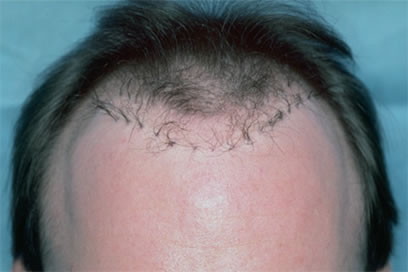
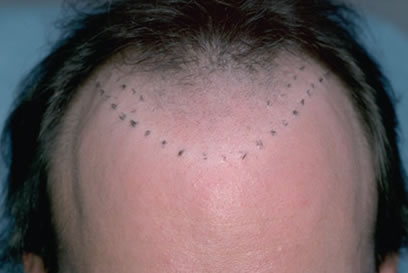

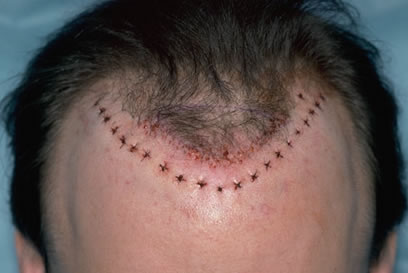

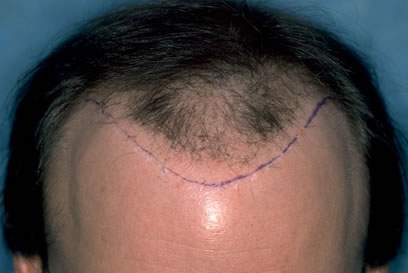
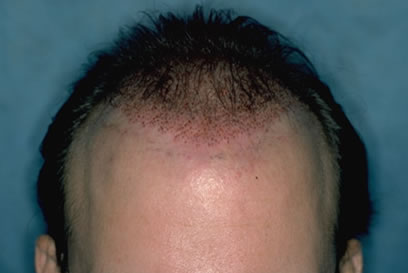
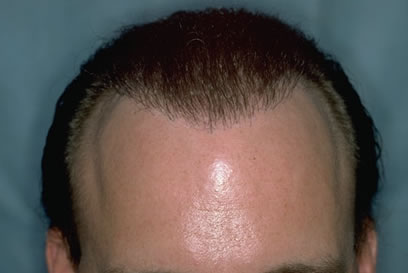
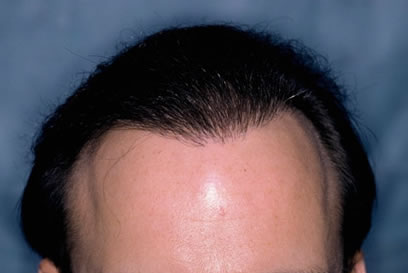

Example 2
Patient BEI had two hair restoration sessions of large minigrafts that produced a pluggy, uneven hairline. BEI expressed an interest in having only the minimum number of grafts removed, so we excised the largest ones located at the frontal hairline. The grafts were then dissected into individual follicular units and placed in the frontal scalp a few centimeters behind the previously transplanted hairline. We then performed one camouflage session using hair obtained from the donor area.
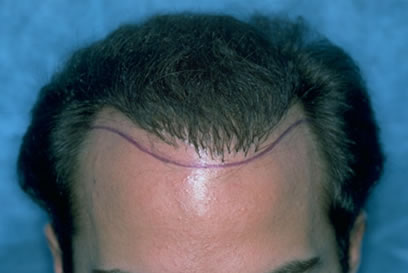
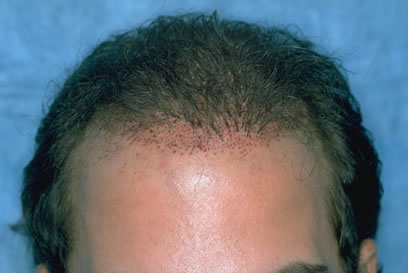
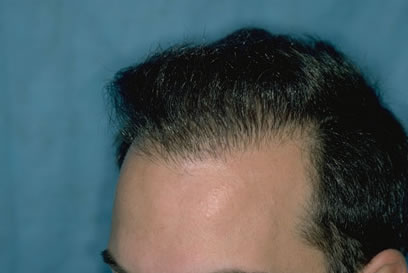
Example 3
The following is a more complicated case. Patient RGL was an early Norwood Class. In 1970, he had a flap procedure. In this outdated technique, a long strip of hair-bearing scalp is removed from the donor area and then sewn intact into the front part of the scalp to create a very dense hairline. This hair restoration procedure, devised by Vallis, is called a free flap because it completely removes the strip of tissue from the donor area. In the more common (but also outdated) rotation flap procedure, the strip of donor tissue is separated on three sides from the scalp and then rotated around the remaining side (called a pedicle) into position at the frontal hairline. Following his flap procedure, RGL had two large graft transplants that added an unnatural, pluggy look to the already linear appearance of the flap.
To decrease the pluggy appearance of the grafts and harshness of the flap, we removed 44 large grafts that included sections of the flap and re-implanted them as 142 individual follicular units, mostly on the side opposite the flap. This was followed by two hair transplant procedures totaling 2,922 follicular unit grafts.
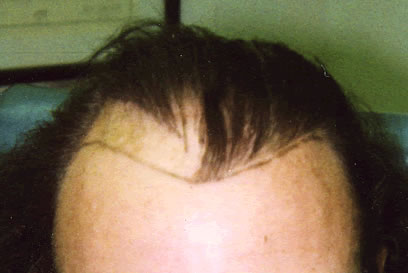
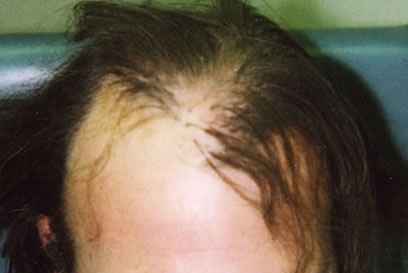
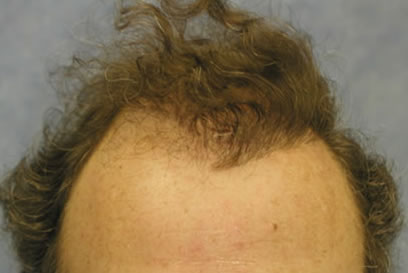
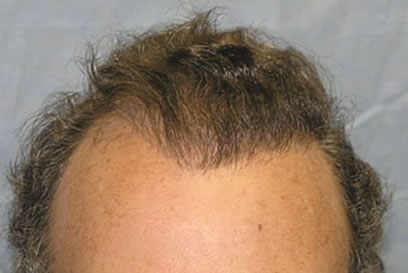
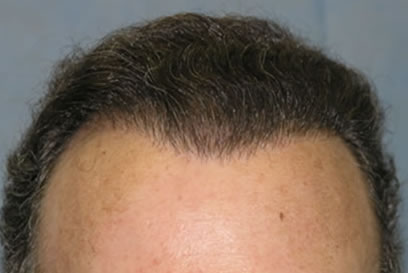
- View Patient RGL’s before and after repair photos
- View more repair patients’ before and after photos
For a comprehensive discussion of corrective hair transplantation procedures read Dr. Bernstein’s paired publications, The Art of Repair in Surgical Hair Restoration: Part 1: Repair Strategies and Part 2: The Tactics of Repair




